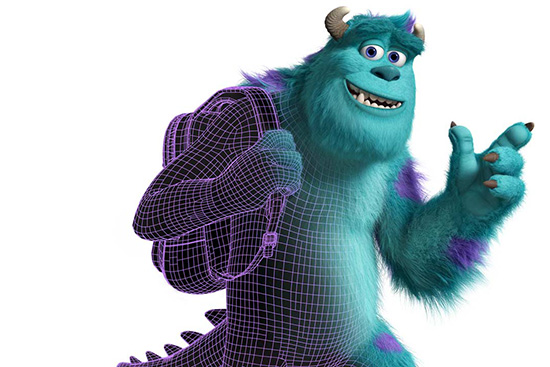Exploring the Science Behind Pixar
Museum of Science offers a glimpse into how studio’s films are made

Sulley, the star of Pixar’s Monsters Inc. and Monsters University, is just one of the characters visitors can pose with in the current Museum of Science exhibition The Science Behind Pixar. Image courtesy of Disney/Pixar
It’s been 20 years since the release of Toy Story—the world’s first computer-animated feature film—put Pixar Animation Studios on the map. Since then, the company has created some of the most successful films of all time, including A Bug’s Life, Toy Story 2, Toy Story 3, Monsters Inc., Finding Nemo, Cars, Wall E, The Incredibles, and the current smash, Inside Out, whose domestic box office take so far is nearly $300 million.
A new Museum of Science exhibition, The Science Behind Pixar, offers a fascinating look at how math, engineering, technology, and science have brought these beloved films to life. The show allows visitors of all ages to follow the production process at Pixar from start to finish. The 10,000-square-foot exhibition features 40 interactive elements as well as firsthand accounts from Pixar animators talking about the ways science and math are used to create characters. Learn how moviemakers work to turn an idea into a film and explore the production pipeline on your own at eight stations: modeling, lighting, simulation, rigging, animation, rendering, surfaces, and sets and cameras.
Visitors can pose with Wall-E, Buzz Lightyear, Sulley, and other characters in the intro area. From there, head to modeling, where you can transform a sketch into a digital sculpture using mathematics the same way the animators did when making Monsters Inc. It’s a not an easy process, which helps explain why 90 percent of the monsters in the movie wound up having the same tongue as Mike, one of the stars.
You’ll see how the properties of light, physics, and mathematics come into play to execute seemingly simple situations, such as moving just one of Princess Merida’s 1,550 individually sculpted curls in Brave or giving Lightning McQueen a new paint job in Cars. You can learn about the techniques used to add color and texture to scenes at the surfaces station and experiment with adding movement to a model via a virtual skeleton at the rigging section. The sets and cameras station allows you to play with 3-D virtual large-scale cameras to re-create the bug’s-eye view achieved in A Bug’s Life. In the lighting section, you’ll get a chance to solve challenges similar to those artists had to contend with in creating animated water with virtual light when making Finding Nemo.
Developed by the Museum of Science in collaboration with Pixar Animation Studios, The Science Behind Pixar offers a first-time look into the Pixar process and the painstaking steps required to create each film (the animators of Up produced an average of only four seconds of material each week).
The Science Behind Pixar is on display through January 10, 2016, in the Museum of Science Nichols Gallery, One Science Park, Boston; hours: 9 a.m. to 7 p.m. Saturday to Thursday and 9 a.m. to 9 p.m. Friday during the summer. Because of the exhibition’s popularity, tickets ($29 for adults, $27 for seniors 60+, $26 for children 3 to 11, and $5 for museum members) are timed and advance reservations are recommended. Admission includes a separate ticket for general Exhibit Halls admission that can be used on the same day or within six months. Purchase tickets in advance here or call 617-723-250. Take an MBTA Green Line trolley to the Science Park stop.
Ashley Mayrianne Jones can be reached at ashjones@bu.edu.
Comments & Discussion
Boston University moderates comments to facilitate an informed, substantive, civil conversation. Abusive, profane, self-promotional, misleading, incoherent or off-topic comments will be rejected. Moderators are staffed during regular business hours (EST) and can only accept comments written in English. Statistics or facts must include a citation or a link to the citation.